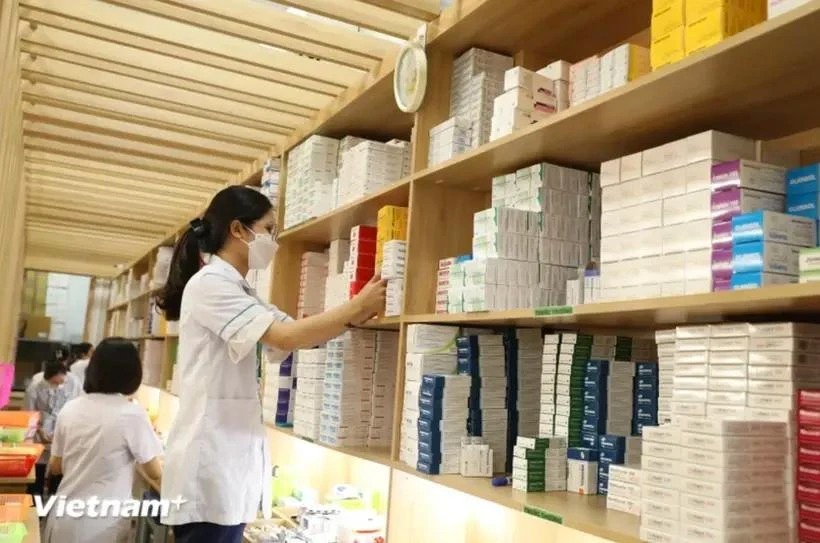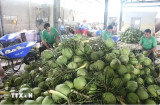Vietnam aims to produce innovative medicines
The Ministry of Health has proposed a policy to encourage the transfer of new and innovative drugs, aiming to create more opportunities for patients.

A medicine warehouse at a hospital. (Illustrative image - Photo: VNA)
The Ministry of Health has proposed a policy to encourage the transfer of new and innovative drugs, aiming to create more opportunities for patients.
According to the ministry’s Drug Administration of Vietnam (DAV), innovative drugs in Vietnam account for only about 3% of the total but represent up to 22% of the value and are primarily imported. Only a few medicines have been researched and produced domestically, or have had initial technology transfer for production.
The main reason is that most domestic pharmaceutical production facilities are currently small- and medium-sized enterprises (SMEs) that have not prioritised investment in research, production, or the transfer of these drugs due to the substantial demand for financial resources, time, and high-quality human resources.
Investment in research and development also remains modest, focusing primarily on conventional drugs, not on research and production of modern pharmaceutical formulations, optimisation of formulas and production.
According to DAV General Director Vu Tuan Cuong, Vietnam encourages the production of generic drugs to ensure essential medicines, and that is why enterprises have not focused on researching and producing hi-tech drugs, new drugs, specifics, or innovative drugs.
He underlined the need to develop incentive mechanisms and policies to attract enterprises and investors, thus promoting investment in researching and developing new technologies for producing priority drugs as proposed in the draft amendment to the Pharmacy Law.
According to DAV, domestically produced drugs currently account for 70% of the quantity used but only about 45-50% in the value. The draft amendment to the Pharmacy Law has proposed regulations to encourage the production of innovative medicines and hi-tech dosage forms, rather than focusing on the production of generic drugs.
The authority reported that Vietnam has 230 pharmaceutical factories that meet GMP-WHO standards, with 20 of them meeting GMP-EU standards. The World Health Organisation (WHO) classifies Vietnam's pharmaceutical industry at Level 3, indicating its capability to produce generic drugs and partially self-sufficient in certain pharmaceutical products. In 2023-2024, the pharmaceutical market is hoped to reach 6.5 - 7 billion USD, with imports accounting for 3.5 billion USD.
Under the national strategy for developing Vietnam’s pharmaceutical industry to 2030, with a vision to 2045, the country aims to become a key hub for the manufacturing, processing, and technology transfer of brand-name drugs, particularly in Southeast Asia.
Additionally, the strategy seeks to elevate the domestic pharmaceutical industry to WHO Level 4, with its export value expected to reach 1 billion USD by 2030.
The strategy also targets domestic medicine production to meet about 80% of the country’s demand, representing 70% of the market value, and to produce 20% of the raw materials needed for the domestic drug production./.
VNA
 Coordination programs are guaranteed to be practical and effective
Coordination programs are guaranteed to be practical and effective
 ENTERPRISES LISTED IN THE GREEN BOOK: Role models on sustainable environmental protection
ENTERPRISES LISTED IN THE GREEN BOOK: Role models on sustainable environmental protection
 Binh Duong-Yamaguchi (Japan): Ten-year connection
Binh Duong-Yamaguchi (Japan): Ten-year connection
 Binh Duong-Ymaguchi (Japan): Ten-year connection
Binh Duong-Ymaguchi (Japan): Ten-year connection
 Binh Duong - Yamaguchi (Japan): Ten-year connection
Binh Duong - Yamaguchi (Japan): Ten-year connection
 The driving force incurred by major constructions
The driving force incurred by major constructions
 Vietnam needs 14 billion USD to develop EV charging stations
Vietnam needs 14 billion USD to develop EV charging stations
 Bright prospects in exports
Bright prospects in exports
 Focus on infrastructure development increases investment attraction
Focus on infrastructure development increases investment attraction
 Today (December 11), the conference to announce the Construction Planning of Phu Giao District until 2040 took place
Today (December 11), the conference to announce the Construction Planning of Phu Giao District until 2040 took place







